The Supermicro H11DSi Motherboard Mini-Review: The Sole Dual EPYC Solution
by Dr. Ian Cutress on May 13, 2020 8:00 AM EST- Posted in
- Motherboards
- AMD
- Supermicro
- Naples
- EPYC
- 10GbE
- Rome
- H11DSi
IPMI
I often find with dual socket motherboards that some extra love and care is needed to get them to work properly, especially because normal troubleshooting techniques we get on consumer motherboards (like a two-digit debug) aren’t present. This is where the baseband management controller comes in, and being able to remote access the system over the network.
One of the new features that Supermicro has implemented here, due to California law, is that no system can be shipped with a default admin/password combination any more. The H11DSi still has the main admin user as ADMIN, but the password is printed on a sticker on the motherboard – you’ll find it in the area just below the DRAM slots. Ours was a 10-letter password in all caps.
By default the IPMI interface will accept a DHCP IP, although this can be changed. Once entered, we get Supermicro’s latest interface.
Within the first few pages is the system as detected, and we can see here it detects the two processors as well as the memory and BIOS versions. Users can update the BIOS and BMC through this interface.
There are 54 sensors on the motherboard, relating to temperature, voltages, and fan speeds. Through the IPMI, users can set high and low limits for any of these sensors. Any discrepancy from the expected values is recorded in the health log.
The big area for the IPMI is the configuration tab, which offers access to networking and server controls.
Ports can also be set for the various use cases.
One thing to note with this motherboard is the fan speeds. While there are eight different 4-pin fan headers on the board, the amount of control offered to the end-user is pitiful. There is nothing in the BIOS to allow users to control the fan speed – instead a user has to access the IPMI, and even then the options are limited to four:
By default this is set to Optimal Speed, but a modern system should be able to support fan curves. It seems odd that consumer motherboards are by far ahead of the curve here, as fan control might be something required for a server board depending on the environment.
Like most server motherboards, there is also a service log to show what was changed and when.
For remote control/iKVM, the interface supports only a HTML5 login, which is how we accessed the system. The interface allows for full power control, including a software shutdown mode.




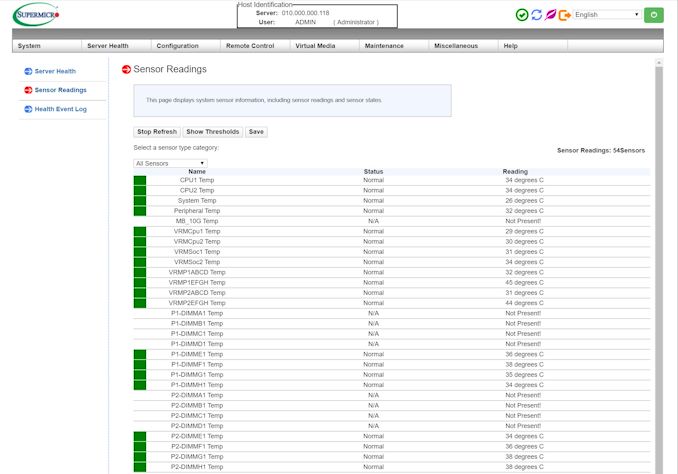
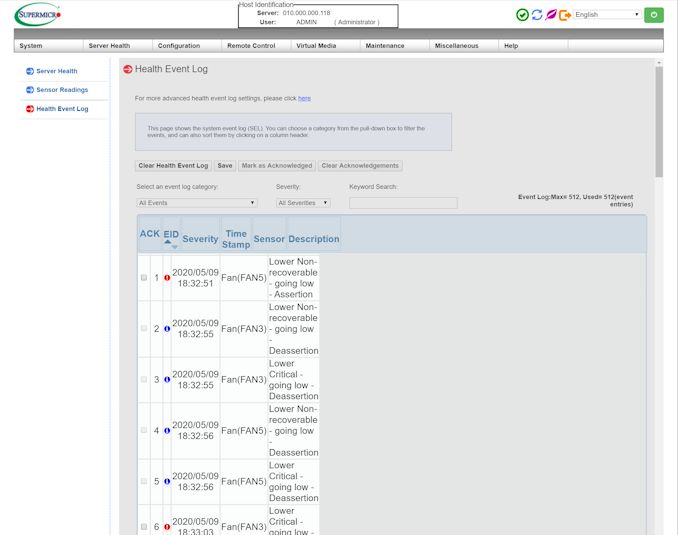
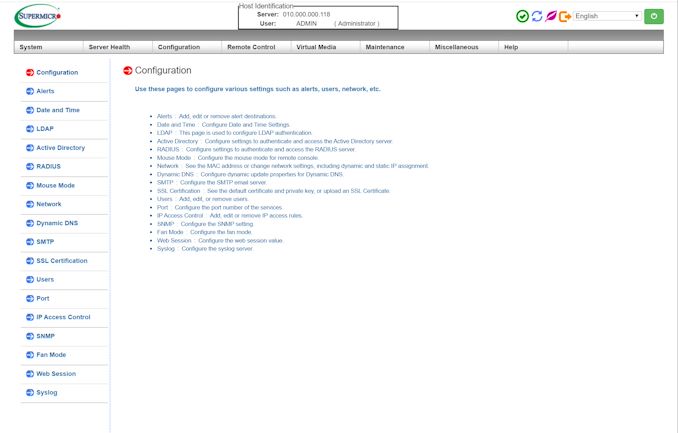
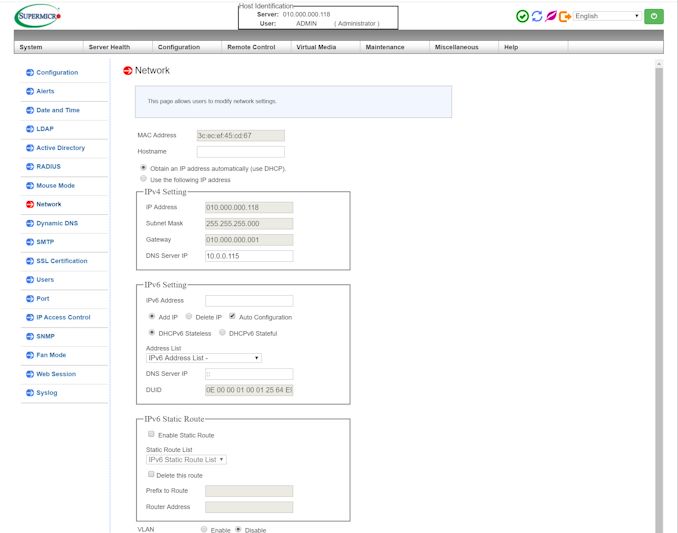
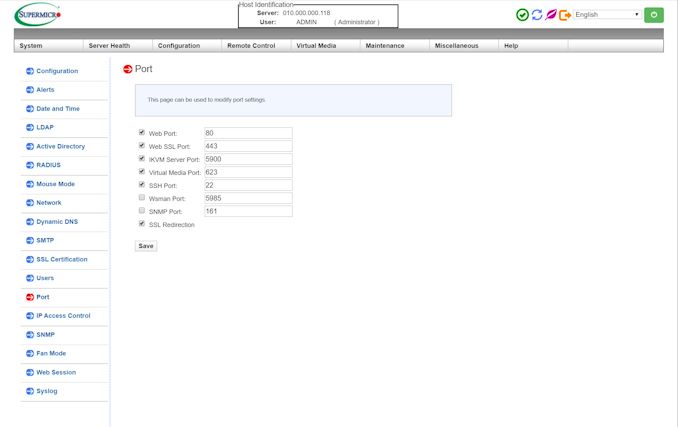
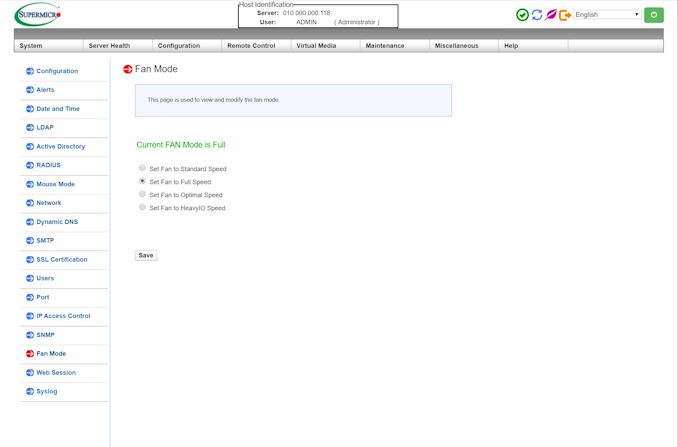
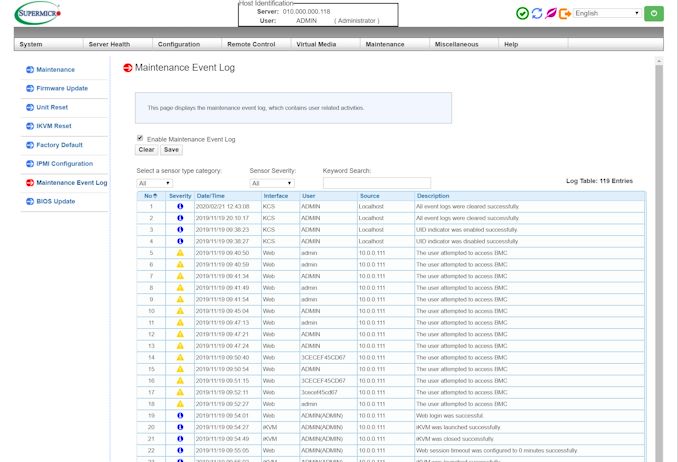
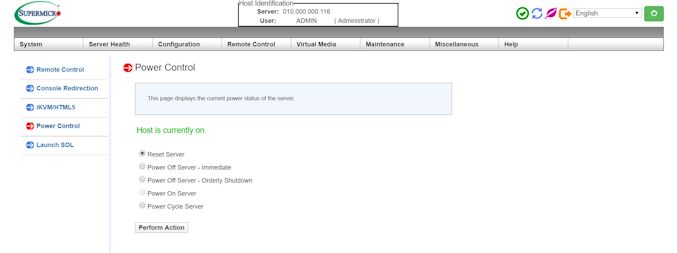














36 Comments
View All Comments
eek2121 - Wednesday, May 13, 2020 - link
A though I had: It would be nice if PCIE latency could be measured going forward.headeffects - Wednesday, May 13, 2020 - link
Can you explain a bit why ECC is less useful now than on the past? I’m curious.AntonErtl - Thursday, May 14, 2020 - link
All sTRX4 (Threadripper 3000 socket) boards listed on https://geizhals.at/?cat=mbstrx4 are listed as supporting ECC. Even a number of mainstream desktop boards (primarily from Asrock and ASUS) support ECC and we have built servers with them, and we have tested that ECC works.Micronsystems - Friday, May 15, 2020 - link
Much informative blog.Reach Micronsystems for the best<a href = "https://www.micronsystems.co.in/">desktop rental in chennai</a>
fakemoth - Friday, May 15, 2020 - link
Long time lurker here, love Anandtech. I had to register an account for this article in order to join the disappointment gang: there is a ridiculous low number of ATX formats options for AMD EPYC, and when talking Rome and PCI gen4, even lower. Found this the hard way: I hardly managed to get a Gigabyte MZ32-AR0 after months of waiting in vain for Supermicro to release some standard ATX/eATX with PCI gen4. Nowadays they seem to have some H12 models out, but of course those are nowhere to be found. If you want to buy one that is.Problem is: now there is no new dual socket option! Exactly when I bought a 7402 Epyc, not a P part as usual... Supermicro is simply missing the server CPU party of the decade. We hope that the press can push things in the right direction, as it is not the time for big manufacturers to arbor the Intel fanboy flags. They did it for a very boringly long time, I just can't believe there isn't the slightest interest in the Rome platform. Because that's what it is: an astounding lack of interest and a very obtuse technology angle, that awful "partnership" inertia that plagues the server/workstations market. It seems that being future proof is a crime in this area.
It speaks for itself: we are reading here a review of a board that is 2 years old and got a revision half a year ago... Yeap, the cheapo BIOS revision, that one.
One thing about the article: the BIOS can't usually be updated via IPMI for Supermicro boards without a license. Only the firmware. Is this still the case or not?
Thank you Anandtech for reviewing enterprise, but standard formats (there shouldn't exist anything else, but that's just me)! Supermicro makes cool tech and I own a bunch, but sometimes, man...
JustTheInductions - Friday, May 15, 2020 - link
PCIe Gen 4. Supporting the feature set of the expensive CPUs you plan on utilizing is a necessity. Support a competitor to SuperMicro to get the board manufacturers to provide more support, AMD. We all know competition engenders motivation to get off one's arse . . .Deicidium369 - Monday, May 18, 2020 - link
Which competitor is that?JustTheInductions - Friday, May 29, 2020 - link
Probably ASRock Rack.kwinz - Saturday, May 16, 2020 - link
E-ATX is just a painful form factor for a dual socket EPYC. Think of all the PCIe lanes that you can never use.Deicidium369 - Monday, May 18, 2020 - link
Even if all the slots were available - you still would not have a use for 128+ lanes. I know the big number is enticing - but in reality - like the 16C desktop CPUs - it's just a marketing gimmick. It's like having a car with 3000HP and it only gets driven in Manhattan - Cool that you have 3000HP, but in reality, not much use.